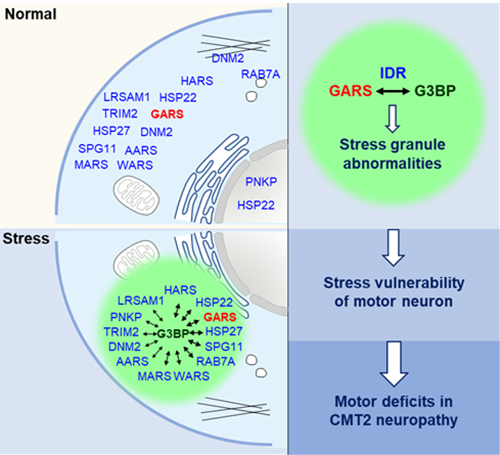
Figure The mechanistic commonalities of diverse CMT2 proteins
Supported by the National Natural Science Foundation of China (Grant No.82150003, 91949104, and 31871022), the joint research team led by Professor Ge Bai from the School of Brain Science and Brain Medicine, School of Medicine of Zhejiang University, together with the research team led by Professor Jinsong Li from the Center for Excellence in Molecular Cell Science of Chinese Academy of Sciences have made important progress on uncovering the pathogenic mechanism of Charcot-Marie-Tooth neuropathies (CMT). The research results were published online as a cover story entitled “Diverse CMT2 Neuropathies are Linked to Aberrant G3BP Interactions in Stress Granules” in Cell on February 3rd, 2023.
Article link: http://doi.org/10.1016/j.cell.2022.12.046.
CMT is a group of peripheral neurogenetic diseases that are commonly seen in clinics. According to different causal genes, CMT can be further divided into over 70 sub-types. Despite similar clinical presentation among different CMT2 sub-types, their causal proteins are highly varied in their cellular localizations and functions. The molecular mechanism underlying their genetic heterogeneity remained unclear. This research focused on glycyl-tRNA synthetase (GlyRS), a CMT2D-causing mutant protein, and employed a combination of approaches, including live-cell imaging, proximity labeling, quantitative MS-based proteomics, super-resolution imaging (STORM). The research found that, upon exposure to environmental stressors, GlyRS adopted a new cellular location in stress granules (SGs), distinct from its normal cytoplasmic location. In SGs, mutant GlyRS perturbed the G3BP-centric core SG network by aberrantly binding to G3BP, causing the over-sequestration of non-SG molecules in SGs, thereby disturbing the cellular stress response and leading to an increased stress vulnerability in motor neurons. Disrupting their aberrant interaction eliminated the impact of mutant GlyRS on SGs, improved the stress-vulnerability of motor neurons, and alleviated motor deficits in CMT2D mouse models. Moreover, the research found that a similar mechanism was largely shared by many other CMT2 subtypes (Figure).
This study identified SG abnormality as an important pathogenic mechanism underlying CMT pathogenesis, established a conceptual framework for the development of broad-spectrum therapeutic drugs for various CMT subtypes, and provided insight into understanding the genetic heterogeneity of other complex diseases.

Add: 83 Shuangqing Rd., Haidian District, Beijing, China
Postcode: 100085
Tel: 86-10-62327001
Fax: 86-10-62327004
E-mail: bic@donnasnhdiary.org
京ICP备05002826号 文保网安备1101080035号 Copyright 2017 NSFC, All Right Reserved